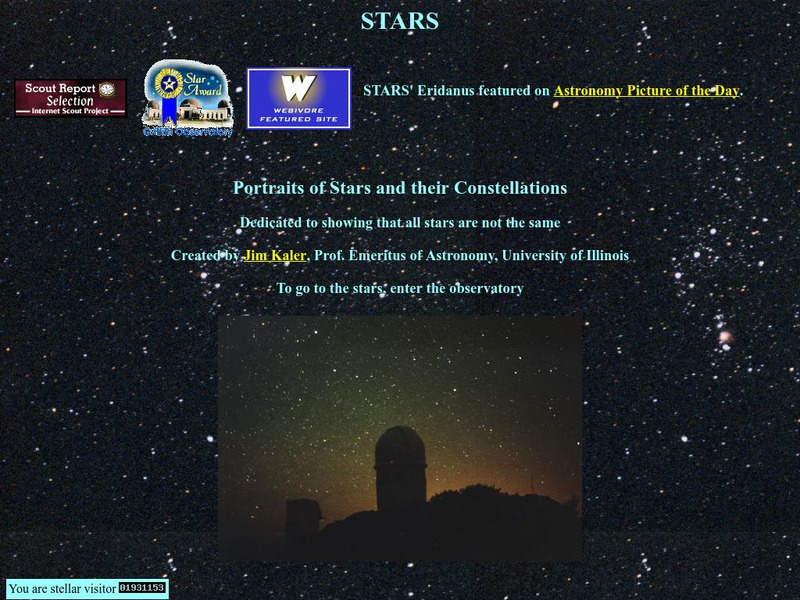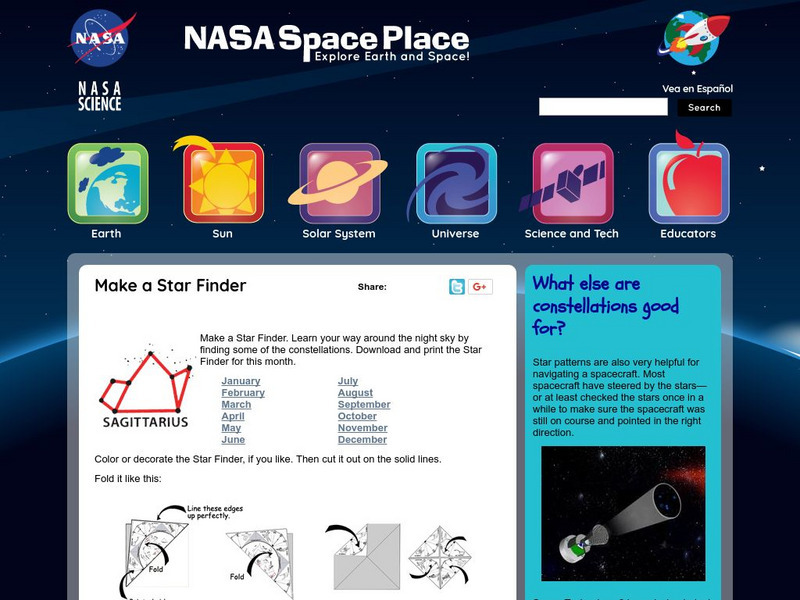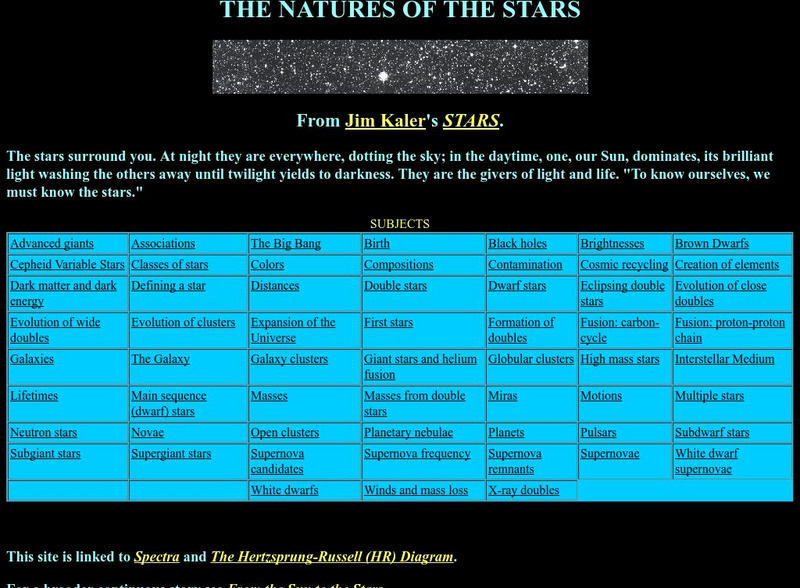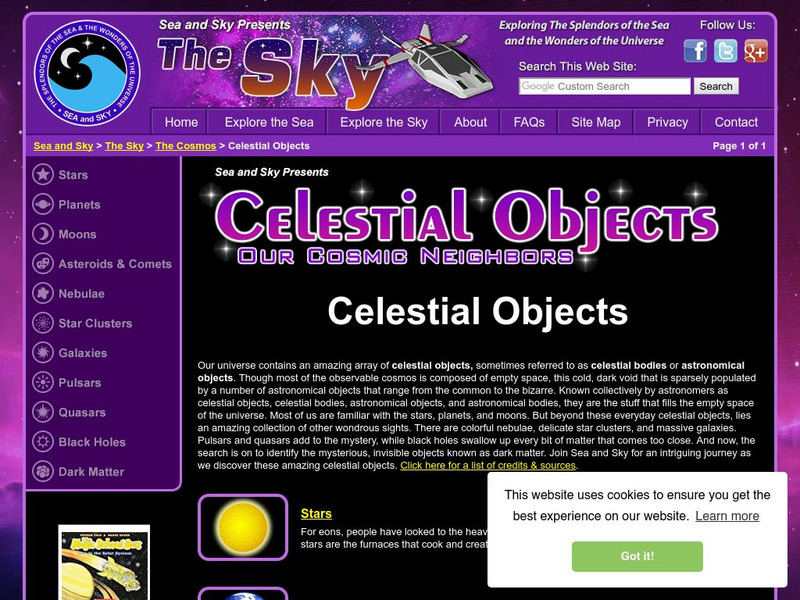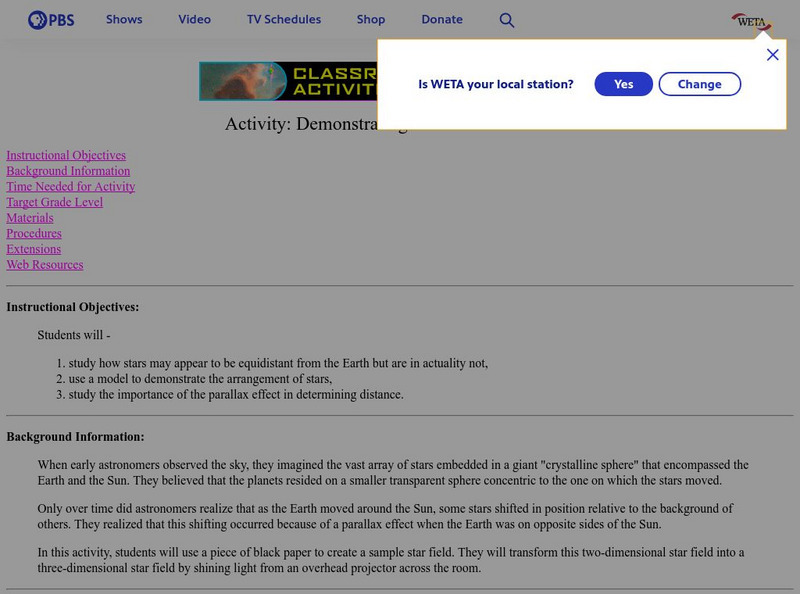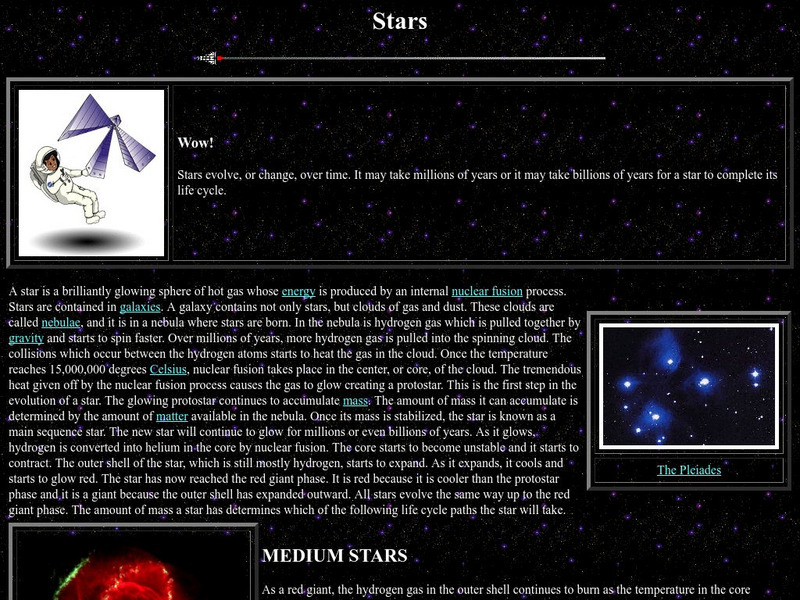ClassFlow
Class Flow: Space
[Free Registration/Login Required] This flipchart describes what causes the seasons, explains the moon's phases, and introduces what a constellation is. It utilizes the Activotes to help describe the phenomena.
University of Illinois
University of Illinois: Stars and Constellations
A large collection of information about and photos of the starts and constellations in the sky.
NASA
Nasa: Jet Propulsion Laboratory: Planet Quest: Exoplanet Exploration
Constellation of articles, images, diagrams, posters, videos, and more on the subject of the search for planets, particularly Earth-like planets, outside our solar system.
Globio
Glossopedia: Stars
Many of the objects you can see in the night sky are stars, large objects in space that produce light. Our galaxy, the Milky Way, contains more than 100 billion stars. Stars are so far away that their light does not reach us for years....
NASA
Nasa: Make a Star Finder
Learning game and activity that teaches about the constellations by making a star finder to help locate them.
Other
Astromador: Astronomia Para Amadores
This resources focuses exclusively on astronomy. It's packed with historical facts about space exploration, famous people who pioneered the study of stars and planets. It features chronological list of space exploration, current news,...
E-learning for Kids
E Learning for Kids: Science: Antarctica/ What Are the Different Parts of the Universe?
In this lesson, students learn about objects in the universe, including constellations, planets, meteors, asteroids, and comets.
University of Illinois
University of Illinois: Stars and Constellations: Neutron Stars and Pulsars
This resource provides a brief description of the relationship between a neutron star and a pulsar. It details the pulsing rate and death of a pulsar.
Other
Sea and Sky: Celestial Objects
Empty space in outer space is not truly empty. Celestial objects fill the space not occupied by planets, stars, and such. This resource identifies these objects and further explains their existence.
ClassFlow
Class Flow: Orion
[Free Registration/Login Required] This flipchart features a well-known constellation in our skies - Orion.
Other
World Wide Telescope
After downloading the WorldWide Telescope software, students can explore the universe with three-dimensional navigation and narrated guided tours of the sky. Users can also import their own tour to share with others. Site has educator...
Utah STEM Foundation
Utah Stem Action Center: Together We Can Rule the Galaxy
In this lesson, learners will learn about Galileo Galilei and space.
University of Illinois
University of Illinois: Stars and Constellations: White Dwarf Supernovae
Discusses the formation of the white dwarf and the role this star plays in the formation of a white dwarf supernovae.
University of Illinois
University of Illinois: Stars and Constellations: Planetary Nebulae
This resource contains information about planetary nebulae and their characteristics.
NASA
Nasa: Make Star Cookies
This site from the National Aeronautics and Space Administration provides a fun project on stars and cookies. "Make these yummy star cookies with genuine star-colored centers you can see through." Plus, learn interesting facts about...
ClassFlow
Class Flow: Astronomy Parallax
[Free Registration/Login Required] This flipchart explains the significance of Delta Cephei in the constellation Cepheus and its historical significance in determining distances in space. It discusses parallax, standard candles, and the...
PBS
Pbs Teachers: Demonstrating the Distances of Stars
Investigate the use of the parallax effect for determining distance in space, and explore the arrangement and relative distance of stars in the galaxy. Create a sample star field and transform it into a three-dimensional model.
NASA
Nasa Star Child: Stars (Level 2)
This NASA site that explains the notable features of stars and constellations, including medium and massive stars. Many terms are clickable links to definitions. There is also a link to the Level 1 version of this site, which is written...
California Institute of Technology
Spitzer Science Center: Red Giant Image
This image features two views of the "bow shock" of a dying star in the Hydra Constellation. The text below the image proceeds to explain a "bow shock" in relation to the red giant star pictured.
Cosmo Learning
Cosmo Learning: Principles of Digital Communications I
A collection of video lectures from a course introducing students to the theory and practices in digital communications. Webpage includes twenty-four lectures from a professor at the Massachusetts Institute of Technology. Lectures vary...
Wikimedia
Wikipedia: The Black Hole
This site examines the black hole as an object in astrophysics. Delve into this comprehensive resource that covers this concept from its history, to qualitative physics, the reality of black holes, mathematical physics and more.
Other
Stellarium: Planetarium
Bring a planetarium to your computer with this free open source software. Download the software to show the sky in 3D with the naked eye.
Other
Paper Plate Education: Serving the Universe on a Paper Plate
Excellent resource for "paper-plate" activities that help simplify various astronomy topics. Learn how to build a "Moon Finder" and "Planet Pointer," and create a paper-plate model that explains the Transit of Venus.



